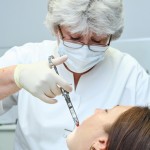
The inferior alveolar nerve block is routinely used for local anaesthesia of the posterior mandibular teeth however the success rate is not 100% and for teeth with pulpitis ranges between 14-57%. Several difference anaesthetic agents have been used (articaine, mepivacaine. prilocaine, levobupivacaine, ropivacaine, bupivacaine, etidocaine, ropivacaine) although lidocaine is most commonly used. Additives such as mannitol and sodium bicarbonate have been incorporated into lidocaine to improve the efficacy of inferior alveolar nerve block with studies suggesting inconsistent outcomes.
The aim of this review was to assess the effect of additives incorporated into lidocaine solution on the success of inferior alveolar nerve block (IANB).
Methods
A protocol was registered on PROSPERO and searches conducted in the Cochrane Central Register of Controlled Trials (CENTRAL), EBSCO, Embase, OpenGrey, ProQuest, PubMed, Scopus, and Web of Science databases. Randomised controlled trials (RCTs) assessing the effect of different additives incorporated into the lidocaine solution on the success rate of pulpal anaesthesia of mandibular posterior teeth with either a diagnosis of normal pulp (NP) or symptomatic apical periodontitis (SAP) in adult patients (>18 years old) using IANB and published in English were considered. Two reviewers independently screen and selected studies extracted data and assessed risk of bias using the Cochrane domains-based tool. Pulpal anaesthesia success was the main outcome measure assessed as risk ratio (RR) with 95% confidence intervals (CI). The Grading of Recommendations, Assessment, Development and Evaluations (GRADE) approach was used to assess the certainty of the evidence.
Results
- 12 studies were included 7 involving NP and 5 for teeth with symptomatic irreversible pulpitis (SIP).
- 307 patients were involved in studies involving NP with 3 studies testing mannitol, and singles studies testing diphenhydramine, hyaluronidase, meperidine, and sodium bicarbonate.
- Meta-analysis for the NP group showed no significant effect for additives overall on pulpal anaesthesia, RR = 0.4 (95%CI; 0.53 to 1.32).
- 434 patients were included in studies of SIP with 2 studies testing sodium bicarbonate, 2 mannitol, and single studies testing meperidine and dexamethasone.
- Meta-analysis for the SIP group showed no significant effect for additives overall on pulpal anaesthesia, RR = 1.22 (95%CI; 0.9 to 1.52).
- The GRADE certainty of the evidence was assessed as low for the SIP group and very low for the NP group.
Conclusions
The authors concluded: –
….very low to low certainty of evidence indicated that incorporating additives into lidocaine solution did not increase the success rate of the IANB and supplemental injections are still required to assist the practitioners achieve painless dental procedures.
Comments
The reviewers have searched an extensive range of databases however restricting inclusion to English publication may have excluded some relevant studies. Achieving a high level of local anaesthetic success is important to the provision of pain free dentistry and a number of anaesthetic techniques and agents of different concentrations have been studied. This review focuses on lidocaine and various additives with the findings only identifying very low to low certainty evidence of a beneficial effect. Given the large number of local anaesthetics provided for dental treatments only a small number of studies could be included in the review and the was variation in the volume and concentration of the anaesthetic agent, epinephrine and the additives used. In addition, the sample size of the included studies was generally small, a factor common in other dental local anaesthetic studies. Future studies need to be well conducted and reported using commonly agreed items and outcome measures to improve the certainty of evidence on local anaesthetic use in dentistry.
Links
Primary Paper
Iranmanesh P, Khazaei S, Nili M, Saatchi M, Aggarwal V, Kolahi J, Khademi A. Anaesthetic efficacy of incorporating different additives into lidocaine for the inferior alveolar nerve block: A systematic review with meta-analysis and trial sequential analysis. Int Endod J. 2022 Apr 10. doi: 10.1111/iej.13746. Epub ahead of print. PMID: 35398916.
Other references
Dental Elf – 24th Jan 2022
Dental Elf – 21st Sep 202
Dental Elf – 25th Feb 2020
Dental Elf – 8th Nov 2019
Dental Elf – Inferior alveolar nerve block blogs
